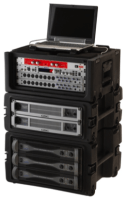
According to the Bureau of Labor Statistics (BLS), back pain is one of the leading reasons for workplace absence. The data reveals many of these injuries occur while lifting. That’s why it’s important to not lift too much and minimize twisting while lifting.
OHSA has no concise recommendations for the maximum load to be lifted. Instead, they defer to a complex equation developed by the National Institute for Occupational Safety and Health (NIOSH). This divides the weight of a load by a “Recommended Weight Limit” (RWL) number to arrive at a “Lifting Index”. OHSA advises that a Lifting Index over three increases the risk of back injury.
A more practical source of information is MIL-STD-1472G. This standard sets out design criteria for military equipment, including maximum design weight limits. These are related to the height a load will be lifted and the distance it will be carried.
The higher a load is to be raised, the lower the recommended limit. So, while the limit for what a man should lift from floor to bench is 87 lbs. (39.5 kg), when lifting above shoulder height, it drops to 48 lbs. (21.9 kg.) For women, the limits are 44 lbs. (20 kg) and 31 lbs. (14 kg) respectively.
If there’s repetitive lifting, if there’s twisting or if the load gets larger, the limits should be lowered. Details are provided in the standard.
The MIL-STD-1472G limits are for one person lifting with one or two hands. Two people can lift twice as much as one, providing the weight is evenly distributed. That’s why a “2 person lift limit” is often called out in equipment specifications. It allows a maximum load of 174 lbs. (79 kg.)
Transit cases come with heavy-duty handles, so they can be lifted in and out of trucks and onto benches or tables. These handles are recessed to avoid wasting storage space. Depending on their size, there will be one or two handles on each side, allowing for a two-person lift.
If the total weight of a case and payload exceeds the design limits, it’s best to split the load between two cases. If that isn’t possible, use other handling methods, like forklift skids, casters or lifting rings. Lifting cases greater than the recommended limits can easily result in a back injury.
U.S. Department of Labor
Bureau of Labor Statistics